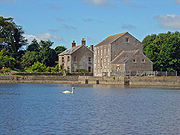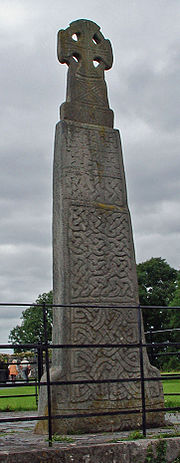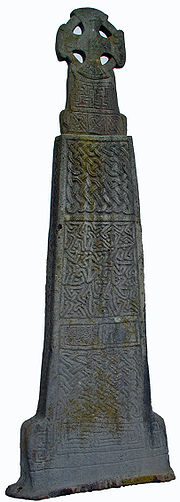
Carew, Pembrokeshire
Encyclopedia
Carew is a village
, community
and parish
on an inlet
of Milford Haven
in the former Hundred of Narberth
, Pembrokeshire
, West Wales
, 7 km east of Pembroke
. The eastern part of the parish
is included in the Pembrokeshire Coast National Park
.

castle
. The parish includes several other villages and hamlets, including Cheriton (around the parish church), Milton, Newton, West Williamston, Sageston and Whitehill.

 Textile mills gave Milton its name. In the 19th century there was a carding
Textile mills gave Milton its name. In the 19th century there was a carding
mill downstream, a weaving mill by the bridge, and a fulling
mill upstream. West Williamston has an almost-disappeared industrial history. Limestone
was quarried in the area for centuries. The stone was cut from slot-shaped flooded quarries communicating with the haven, known locally as "docks". See examples at 51°42′29"N 4°50′35"W. These allowed stone to be dropped from the quarry faces directly into barges at the bottom. From there, stone was shipped to lime kilns all around the coast of North Pembrokeshire and Cardiganshire
. A small inland quarry still operates just north of Carew village. Besides limestone
, anthracite was mined on a small scale for local consumption at Minnis Pit on the northeastern edge of the parish.
Typical of South Pembrokeshire
, the parish has been predominantly English-speaking since the 12th century.
Village
A village is a clustered human settlement or community, larger than a hamlet with the population ranging from a few hundred to a few thousand , Though often located in rural areas, the term urban village is also applied to certain urban neighbourhoods, such as the West Village in Manhattan, New...
, community
Community (Wales)
A community is a division of land in Wales that forms the lowest-tier of local government in Wales. Welsh communities are analogous to civil parishes in England....
and parish
Civil parish
In England, a civil parish is a territorial designation and, where they are found, the lowest tier of local government below districts and counties...
on an inlet
Inlet
An inlet is a narrow body of water between islands or leading inland from a larger body of water, often leading to an enclosed body of water, such as a sound, bay, lagoon or marsh. In sea coasts an inlet usually refers to the actual connection between a bay and the ocean and is often called an...
of Milford Haven
Milford Haven (harbour)
Milford Haven Waterway is a natural harbour in Pembrokeshire, West Wales. The Haven is a ria or drowned valley flooded at the end of the last Ice Age. formed by the Pembroke River and the Daugleddau estuary, and winds west to the sea...
in the former Hundred of Narberth
Narberth (hundred)
thumb|200px|right|Pembrokeshire showing Narberth HundredThe Hundred of Narberth was a hundred in Pembrokeshire, Wales. It was formed by the Act of Union of 1536 from parts of the pre-Norman cantrefs of Penfro and Cantref Gwarthaf...
, Pembrokeshire
Pembrokeshire
Pembrokeshire is a county in the south west of Wales. It borders Carmarthenshire to the east and Ceredigion to the north east. The county town is Haverfordwest where Pembrokeshire County Council is headquartered....
, West Wales
West Wales
West Wales is the western area of Wales.Some definitions of West Wales include only Pembrokeshire, Ceredigion and Carmarthenshire, an area which historically comprised the Welsh principality of Deheubarth., an area called "South West Wales" in the Nomenclature of Territorial Units for Statistics....
, 7 km east of Pembroke
Pembroke, Pembrokeshire
Pembroke is an historic settlement and former county town of Pembrokeshire in west Wales. The town and the county derive their name from that of the cantref of Penfro: Pen = "head" or "end", and bro = "region", "country", "land", and so it means essentially "Land's End".-History:The main point of...
. The eastern part of the parish
Parish
A parish is a territorial unit historically under the pastoral care and clerical jurisdiction of one parish priest, who might be assisted in his pastoral duties by a curate or curates - also priests but not the parish priest - from a more or less central parish church with its associated organization...
is included in the Pembrokeshire Coast National Park
Pembrokeshire Coast National Park
Pembrokeshire Coast National Park is a national park along the Pembrokeshire coast in West Wales.It was established as a National Park in 1952, and is the only one in the United Kingdom to have been designated primarily because of its spectacular coastline...
.

Description
The meaning of the name is disputed. It is Welsh and could mean "fort on a hill" (Caer-rhiw), "fort by yews" (Caer-yw) or simply "forts" (Caerau). It is pronounced /'kε:ru/, or more traditionally /'kε:ri/. The village grew up to serve the nearby NormanNormans
The Normans were the people who gave their name to Normandy, a region in northern France. They were descended from Norse Viking conquerors of the territory and the native population of Frankish and Gallo-Roman stock...
castle
Castle
A castle is a type of fortified structure built in Europe and the Middle East during the Middle Ages by European nobility. Scholars debate the scope of the word castle, but usually consider it to be the private fortified residence of a lord or noble...
. The parish includes several other villages and hamlets, including Cheriton (around the parish church), Milton, Newton, West Williamston, Sageston and Whitehill.


Carding
Carding is a mechanical process that breaks up locks and unorganised clumps of fibre and then aligns the individual fibres so that they are more or less parallel with each other. The word is derived from the Latin carduus meaning teasel, as dried vegetable teasels were first used to comb the raw wool...
mill downstream, a weaving mill by the bridge, and a fulling
Fulling
Fulling or tucking or walking is a step in woolen clothmaking which involves the cleansing of cloth to eliminate oils, dirt, and other impurities, and making it thicker. The worker who does the job is a fuller, tucker, or walker...
mill upstream. West Williamston has an almost-disappeared industrial history. Limestone
Limestone
Limestone is a sedimentary rock composed largely of the minerals calcite and aragonite, which are different crystal forms of calcium carbonate . Many limestones are composed from skeletal fragments of marine organisms such as coral or foraminifera....
was quarried in the area for centuries. The stone was cut from slot-shaped flooded quarries communicating with the haven, known locally as "docks". See examples at 51°42′29"N 4°50′35"W. These allowed stone to be dropped from the quarry faces directly into barges at the bottom. From there, stone was shipped to lime kilns all around the coast of North Pembrokeshire and Cardiganshire
Ceredigion
Ceredigion is a county and former kingdom in mid-west Wales. As Cardiganshire , it was created in 1282, and was reconstituted as a county under that name in 1996, reverting to Ceredigion a day later...
. A small inland quarry still operates just north of Carew village. Besides limestone
Limestone
Limestone is a sedimentary rock composed largely of the minerals calcite and aragonite, which are different crystal forms of calcium carbonate . Many limestones are composed from skeletal fragments of marine organisms such as coral or foraminifera....
, anthracite was mined on a small scale for local consumption at Minnis Pit on the northeastern edge of the parish.
Typical of South Pembrokeshire
Little England beyond Wales
Little England beyond Wales is a name applied to an area of southern Pembrokeshire and southwestern Carmarthenshire in Wales, which has been English in language and culture for many centuries despite its remoteness from the English border...
, the parish has been predominantly English-speaking since the 12th century.
Features
- The 13th century Norman castleCastleA castle is a type of fortified structure built in Europe and the Middle East during the Middle Ages by European nobility. Scholars debate the scope of the word castle, but usually consider it to be the private fortified residence of a lord or noble...
is 170 m west of the village.
- The French Mill is a rare example of a tidal flour millTide millA tide mill is a water mill driven by tidal rise and fall. A dam with a sluice is created across a suitable tidal inlet, or a section of river estuary is made into a reservoir. As the tide comes in, it enters the mill pond through a one way gate, and this gate closes automatically when the tide...
on a dam across the Carew inlet. The present building dates from the 18th century, but the French Mill was mentioned in 1476. The mill has not functioned since the 1930s, but its equipment is all still in place. It has two large undershot water wheelWater wheelA water wheel is a machine for converting the energy of free-flowing or falling water into useful forms of power. A water wheel consists of a large wooden or metal wheel, with a number of blades or buckets arranged on the outside rim forming the driving surface...
s, driving seven sets of mill stoneMillstoneMillstones or mill stones are used in windmills and watermills, including tide mills, for grinding wheat or other grains.The type of stone most suitable for making millstones is a siliceous rock called burrstone , an open-textured, porous but tough, fine-grained sandstone, or a silicified,...
s.
- The Carew Cross, currently located on the road side in the village, is an important example of an 11th century memorial Celtic crossCeltic crossA Celtic cross is a symbol that combines a cross with a ring surrounding the intersection. In the Celtic Christian world it was combined with the Christian cross and this design was often used for high crosses – a free-standing cross made of stone and often richly decorated...
, commemorating King Maredudd ab Edwin of Deheubarth (died 1035). The cross, 4 m in height, is made from the local limestone. Similar to the NevernNevernNevern is a small village or hamlet, of just a few houses in Pembrokeshire, West Wales. It lies in the valley of the River Nevern close to the Preseli Hills of the Pembrokeshire Coast National Park east of Newport.-Nevern Parish Church:...
cross, it consists of two parts, connected with a tenonMortise and tenonThe mortise and tenon joint has been used for thousands of years by woodworkers around the world to join pieces of wood, mainly when the adjoining pieces connect at an angle of 90°. In its basic form it is both simple and strong. Although there are many joint variations, the basic mortise and tenon...
joint. It is inscribed, on the west face:

